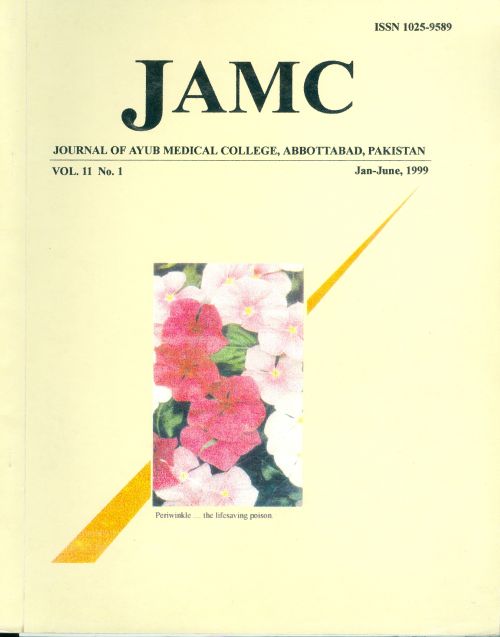PULMONARY FUNCTION TESTS IN CHRONIC OBSTRUCTIVE PULMONARY DISEASE WITH AND WITHOUT CARDIAC FAILURE
Abstract
A total of 95 mate subjects were included during the course of present study. 35 COPD without cardiac failure and30 COPD with cardiac failure. Expiratory spirometry was performed on S- model vitalograph spirometer. Vital
capacity (VC), forced vital capacity (VC), forced expiratory volume one second ( F E V I expiratory ratio (FEV/FVC%)
and forced expiratory flow 25-75% ( F E F 25-75%) were performed on all subjects. The ventilatory functions of the
male adult control of relevant age subgroups were found to decline with advancing age. Pulmonary function tests in
COPD without and with cardiac failure were significantly decreased (p<0.001) when compared with controls. In the
COPD without and with cardiac failure, the difference was statistically insignificant, h was even slightly higher in
COPD with cardiac failure subjects except FEF 25-75%. These tests are therefore valuable for early diagnosis in
COPD subjects but in COPD with cardiac failure their correlation with severity of lung disease is not perfect.
References
Ross JC, Internal medicine, 1st ed., Brown and
company Boston. 1983; p.445-47.
Bennett JC and Plum P. Cecil text book of
medicine 20th ed. W.B. Saunders Company
Philadelphia. 1996; p.38.
Kumar P and Clark M. A text book for medical
students and doctors. 3rd ed. Bailliere tindal,
London 1994; p.659.
Fiel SB. The national medical series for
independent study of medicine, 2nd ed. A wiley
medical publication New York 1986; p.69.
Petty, T.L. (1989) Office spirometry. App
Cardiopulmonary pathophysiology, 3:169-76.
Gandavia B. and Hugh-Jones P (1957).
Terminology for measurements of ventilatory
capacity. Thorax. 12: 290-93.
Mckerrow CB, Mcdermott M and Gilson JC
(I960). A spirometer for measuring the forced
expiratory volume with a simple calibrating
device. Lancet. 1:149-51.
Conchrane GM. Prieto F, Hickey B. Benator SR
and Clark TJH (1994). Early diagnosis of airways
obstruction. Thorax. 29: 389-93.
Vandenberg E, Clement J and Woestijne KPV
(1973). Cause and prognosis of patients with
advanced chronic obstructive pulmonary disease.
Am.J. Med. 55: 736-46.
Kory RC. Callahan R. Boren HG and Syner
MJC (1961). The veteran's administration army
cooperative study of pulmonary- function. I.
Clinical spirometry- in normal men. Am. J. Med.
: 243-58.
Kelle CA, Neil E and Joels N. Samson wrights'
applied physiology, 13th ed. Oxford medical
publication, New York, 1982; p 157.
Campbell EJM, Dickinson CJ and Slater JDH.
Clinical physiology, 13th ed. ELBS and
Blackwell scientific publication, Oxford and
Edinburgh, 1970: p. 124.
Williams DE, Miller RD and Taylor WF (1978).
Pulmonary- function studies in healthy Pakistani
adults. Thorax, 33: 243- 49.
Shepherd RJ and Turner ME (1959). On the
probability of correct diagnosis by pulmonary
function tests. Thorax, 14 300-04.
Hogg JC. Macklem PT and Thurlbeck WM
(1968). Site and nature of airway obstruction in
chronic obstructive lung disease. N. Eng. J. Med.
: 1355-60.
Keller CA, Shepard JW Jr. Chun DS. Vasquez P
and Dolen GF (1986). Pulmonary hypertension in
chronic obstructive pulmonary disease. Chest, 90:
-92.
Downloads
How to Cite
Issue
Section
License
Journal of Ayub Medical College, Abbottabad is an OPEN ACCESS JOURNAL which means that all content is FREELY available without charge to all users whether registered with the journal or not. The work published by J Ayub Med Coll Abbottabad is licensed and distributed under the creative commons License CC BY ND Attribution-NoDerivs. Material printed in this journal is OPEN to access, and are FREE for use in academic and research work with proper citation. J Ayub Med Coll Abbottabad accepts only original material for publication with the understanding that except for abstracts, no part of the data has been published or will be submitted for publication elsewhere before appearing in J Ayub Med Coll Abbottabad. The Editorial Board of J Ayub Med Coll Abbottabad makes every effort to ensure the accuracy and authenticity of material printed in J Ayub Med Coll Abbottabad. However, conclusions and statements expressed are views of the authors and do not reflect the opinion/policy of J Ayub Med Coll Abbottabad or the Editorial Board.
USERS are allowed to read, download, copy, distribute, print, search, or link to the full texts of the articles, or use them for any other lawful purpose, without asking prior permission from the publisher or the author. This is in accordance with the BOAI definition of open access.
AUTHORS retain the rights of free downloading/unlimited e-print of full text and sharing/disseminating the article without any restriction, by any means including twitter, scholarly collaboration networks such as ResearchGate, Academia.eu, and social media sites such as Twitter, LinkedIn, Google Scholar and any other professional or academic networking site.










